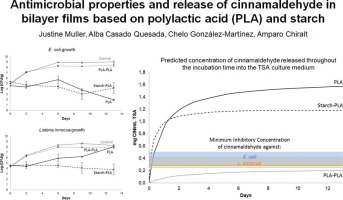当前位置:
X-MOL 学术
›
Eur. Polym. J.
›
论文详情
Our official English website, www.x-mol.net, welcomes your feedback! (Note: you will need to create a separate account there.)
Antimicrobial properties and release of cinnamaldehyde in bilayer films based on polylactic acid (PLA) and starch
European Polymer Journal ( IF 6 ) Pub Date : 2017-11-01 , DOI: 10.1016/j.eurpolymj.2017.09.009 Justine Muller , Alba Casado Quesada , Chelo González-Martínez , Amparo Chiralt
European Polymer Journal ( IF 6 ) Pub Date : 2017-11-01 , DOI: 10.1016/j.eurpolymj.2017.09.009 Justine Muller , Alba Casado Quesada , Chelo González-Martínez , Amparo Chiralt

|
Abstract Cinnamaldehyde (CIN) loaded amorphous PLA films were obtained by casting, using ethyl acetate as solvent. Likewise, bilayer films were obtained by thermocompression of the PLA active layer and compression moulded cassava starch (S) films or semi crystalline PLA films. Starch-PLA laminated materials were considered to improve the barrier capacity (high oxygen barrier through the starch layer and high water vapour capacity through the polyester layer), while CIN incorporation confers antimicrobial activity on the films. The PLA bilayers were obtained for comparison purposes. The antimicrobial activity of the CIN loaded PLA films and S bilayer films was proved against Escherichia coli and Listeria Innocua through in vitro tests, which indicates that the active amount released into the growth medium exceeded the minimum inhibitory concentration (MIC) of both bacteria. The release kinetics of the active compound in different food simulants demonstrated that a part of CIN was tightly bonded to the PLA matrix, whereas the free compound diffused more easily through the starch layer, making S bilayers more active against the bacteria when the starch layer was in direct contact with the culture medium. CIN entrapped in PLA bilayers did not exhibited any antibacterial effect due to its release inhibition, associated to its bonding within the PLA matrix and the lower degree of relaxation in the semi crystalline PLA layer in contact with the food simulants.
中文翻译:

基于聚乳酸 (PLA) 和淀粉的双层膜中肉桂醛的抗菌性能和释放
摘要 以乙酸乙酯为溶剂,通过浇铸获得负载肉桂醛(CIN)的无定形聚乳酸薄膜。同样,双层膜是通过热压 PLA 活性层和压缩成型的木薯淀粉 (S) 膜或半结晶 PLA 膜获得的。淀粉-PLA 层压材料被认为可以提高阻隔能力(通过淀粉层的高氧气阻隔性和通过聚酯层的高水蒸气容量),而 CIN 的掺入赋予薄膜抗菌活性。获得 PLA 双层用于比较目的。通过体外试验证明了负载 CIN 的 PLA 膜和 S 双层膜对大肠杆菌和李斯特菌的抗菌活性,这表明释放到生长培养基中的活性量超过了两种细菌的最小抑菌浓度 (MIC)。活性化合物在不同食品模拟物中的释放动力学表明,一部分 CIN 与 PLA 基质紧密结合,而游离化合物更容易通过淀粉层扩散,使 S 双层对细菌的活性更强。与培养基直接接触。包裹在 PLA 双层中的 CIN 由于其释放抑制作用而没有表现出任何抗菌作用,这与它在 PLA 基质中的结合以及与食品模拟物接触的半结晶 PLA 层的松弛程度较低有关。活性化合物在不同食品模拟物中的释放动力学表明,一部分 CIN 与 PLA 基质紧密结合,而游离化合物更容易通过淀粉层扩散,使 S 双层对细菌的活性更强。与培养基直接接触。包裹在 PLA 双层中的 CIN 由于其释放抑制作用而没有表现出任何抗菌作用,这与它在 PLA 基质中的结合以及与食品模拟物接触的半结晶 PLA 层的松弛程度较低有关。活性化合物在不同食品模拟物中的释放动力学表明,一部分 CIN 与 PLA 基质紧密结合,而游离化合物更容易通过淀粉层扩散,使 S 双层对细菌的活性更强。与培养基直接接触。包裹在 PLA 双层中的 CIN 由于其释放抑制作用而没有表现出任何抗菌作用,这与它在 PLA 基质中的结合以及与食品模拟物接触的半结晶 PLA 层的松弛程度较低有关。
更新日期:2017-11-01
中文翻译:

基于聚乳酸 (PLA) 和淀粉的双层膜中肉桂醛的抗菌性能和释放
摘要 以乙酸乙酯为溶剂,通过浇铸获得负载肉桂醛(CIN)的无定形聚乳酸薄膜。同样,双层膜是通过热压 PLA 活性层和压缩成型的木薯淀粉 (S) 膜或半结晶 PLA 膜获得的。淀粉-PLA 层压材料被认为可以提高阻隔能力(通过淀粉层的高氧气阻隔性和通过聚酯层的高水蒸气容量),而 CIN 的掺入赋予薄膜抗菌活性。获得 PLA 双层用于比较目的。通过体外试验证明了负载 CIN 的 PLA 膜和 S 双层膜对大肠杆菌和李斯特菌的抗菌活性,这表明释放到生长培养基中的活性量超过了两种细菌的最小抑菌浓度 (MIC)。活性化合物在不同食品模拟物中的释放动力学表明,一部分 CIN 与 PLA 基质紧密结合,而游离化合物更容易通过淀粉层扩散,使 S 双层对细菌的活性更强。与培养基直接接触。包裹在 PLA 双层中的 CIN 由于其释放抑制作用而没有表现出任何抗菌作用,这与它在 PLA 基质中的结合以及与食品模拟物接触的半结晶 PLA 层的松弛程度较低有关。活性化合物在不同食品模拟物中的释放动力学表明,一部分 CIN 与 PLA 基质紧密结合,而游离化合物更容易通过淀粉层扩散,使 S 双层对细菌的活性更强。与培养基直接接触。包裹在 PLA 双层中的 CIN 由于其释放抑制作用而没有表现出任何抗菌作用,这与它在 PLA 基质中的结合以及与食品模拟物接触的半结晶 PLA 层的松弛程度较低有关。活性化合物在不同食品模拟物中的释放动力学表明,一部分 CIN 与 PLA 基质紧密结合,而游离化合物更容易通过淀粉层扩散,使 S 双层对细菌的活性更强。与培养基直接接触。包裹在 PLA 双层中的 CIN 由于其释放抑制作用而没有表现出任何抗菌作用,这与它在 PLA 基质中的结合以及与食品模拟物接触的半结晶 PLA 层的松弛程度较低有关。


























 京公网安备 11010802027423号
京公网安备 11010802027423号